Why you can trust Tom's Hardware
Comparison Products
The N300 Pro fits in Toshiba’s lineup alongside the N300, X300, and X300 Pro. On the lower end from WD we have the Red Plus with the Gold at the higher end and the Red Pro in-between. Seagate has its Exos X20/IronWolf Pro 20TB and 14TB IronWolf Pro, plus the surveillance-oriented SkyHawk AI on the table.
Trace Testing — 3DMark Storage Benchmark
Built for gamers, 3DMark’s Storage Benchmark focuses on real-world gaming performance. Each round in this benchmark stresses storage based on gaming activities including loading games, saving progress, installing game files, and recording gameplay video streams.

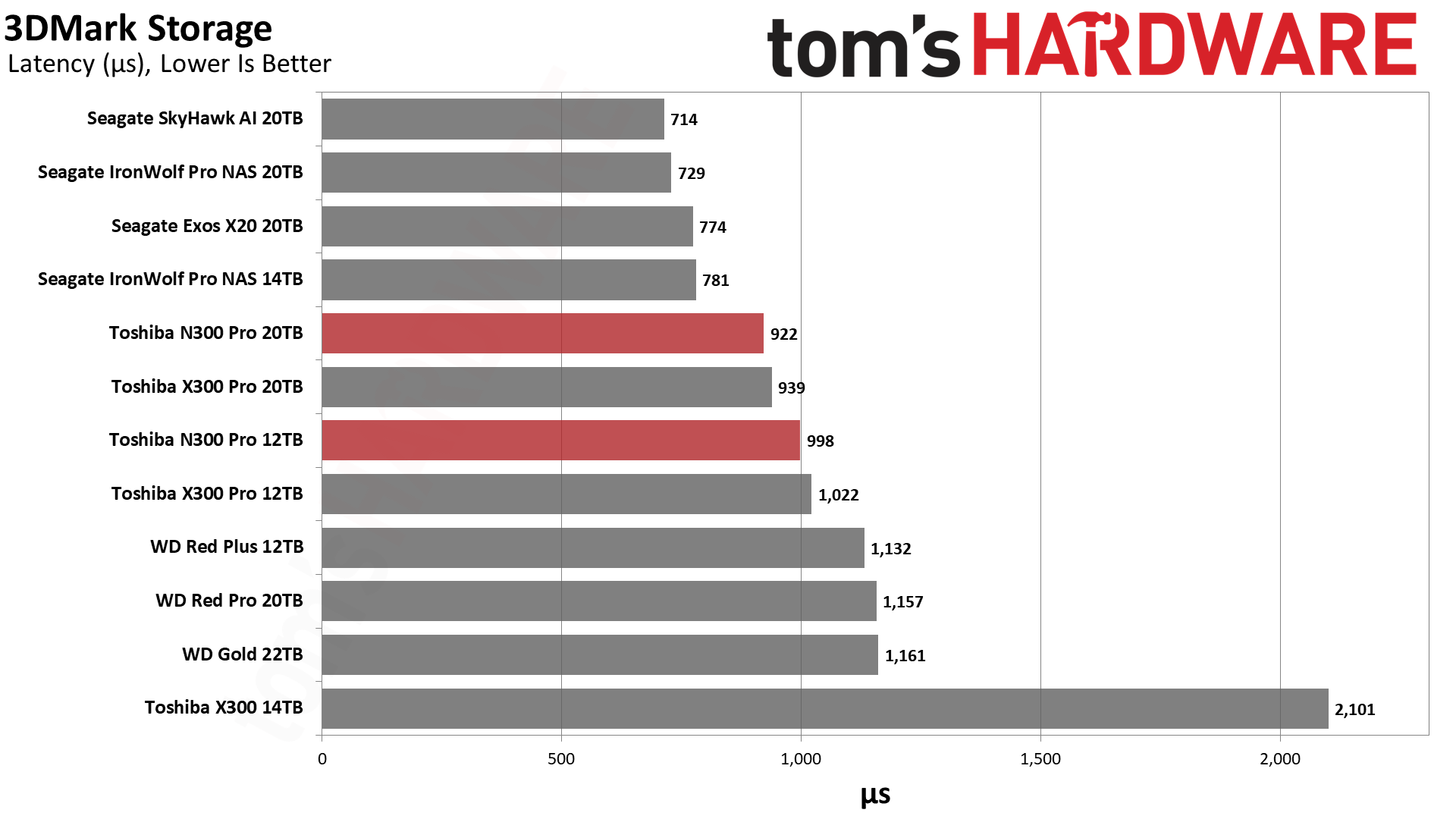
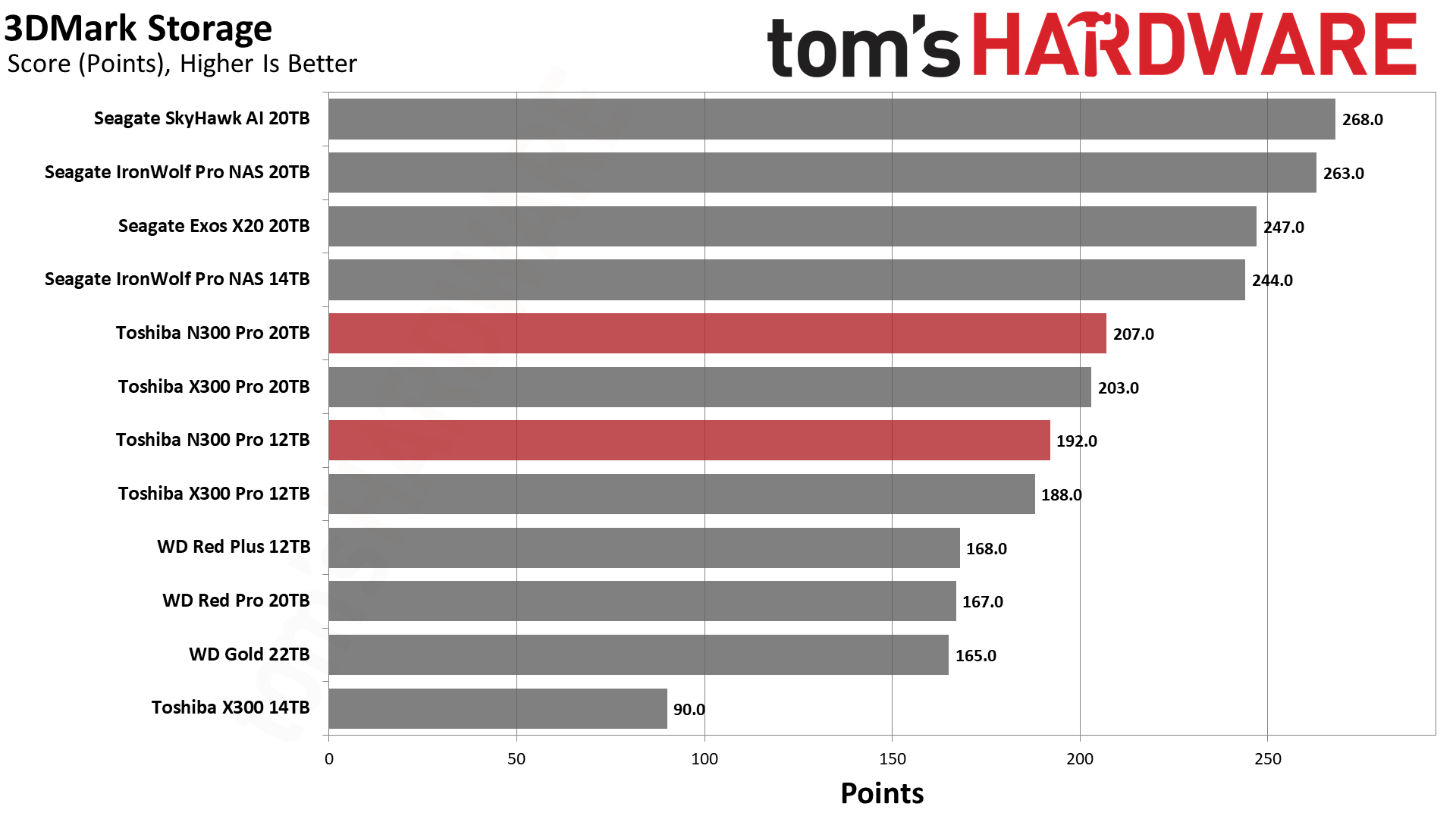
While HDDs are not ideal for modern gaming, they can sometimes be useful for archiving, older games, or truly large collections where internet access may not be fast or guaranteed. While we found the X300 to be abominable in 3DMark, the N300 Pro does quite well. NAS drives are not optimized for this workload, though, and you pay more for multi-drive optimizations and the high level of individual drive capacity.
Barring a good sale, we would recommend caching with an SSD or using a standard hard drive like the Seagate FireCuda, WD Black, or even WD Blue instead. Among the hard drives we've tested, the Seagate high-capacity models outperform the Toshiba drives in this workload, with WD's Red Pro and Red Plus at the bottom of the charts.
Trace Testing — PCMark 10 Storage Benchmark
PCMark 10 is a trace-based benchmark that uses a wide-ranging set of real-world traces from popular applications and everyday tasks to measure the performance of storage devices.



The N300 Pro is middle-of-the-pack in PCMark 10, and while we do not recommend using an HDD for your OS or primary applications it is foreseeable that a NAS drive could be used with network applications. In that respect, the N300 Pro provides more responsiveness by far than the X300 and also over WD’s drives.
Transfer Rates — DiskBench
We use the DiskBench storage benchmarking tool to test file transfer performance with a custom, 50GB dataset. We write 31,227 files of various types, such as pictures, PDFs, and videos to the drive (using an SSD as the source). Then we copy that same data to a new folder, and follow up with a reading test of a newly-written 6.5GB zip file.

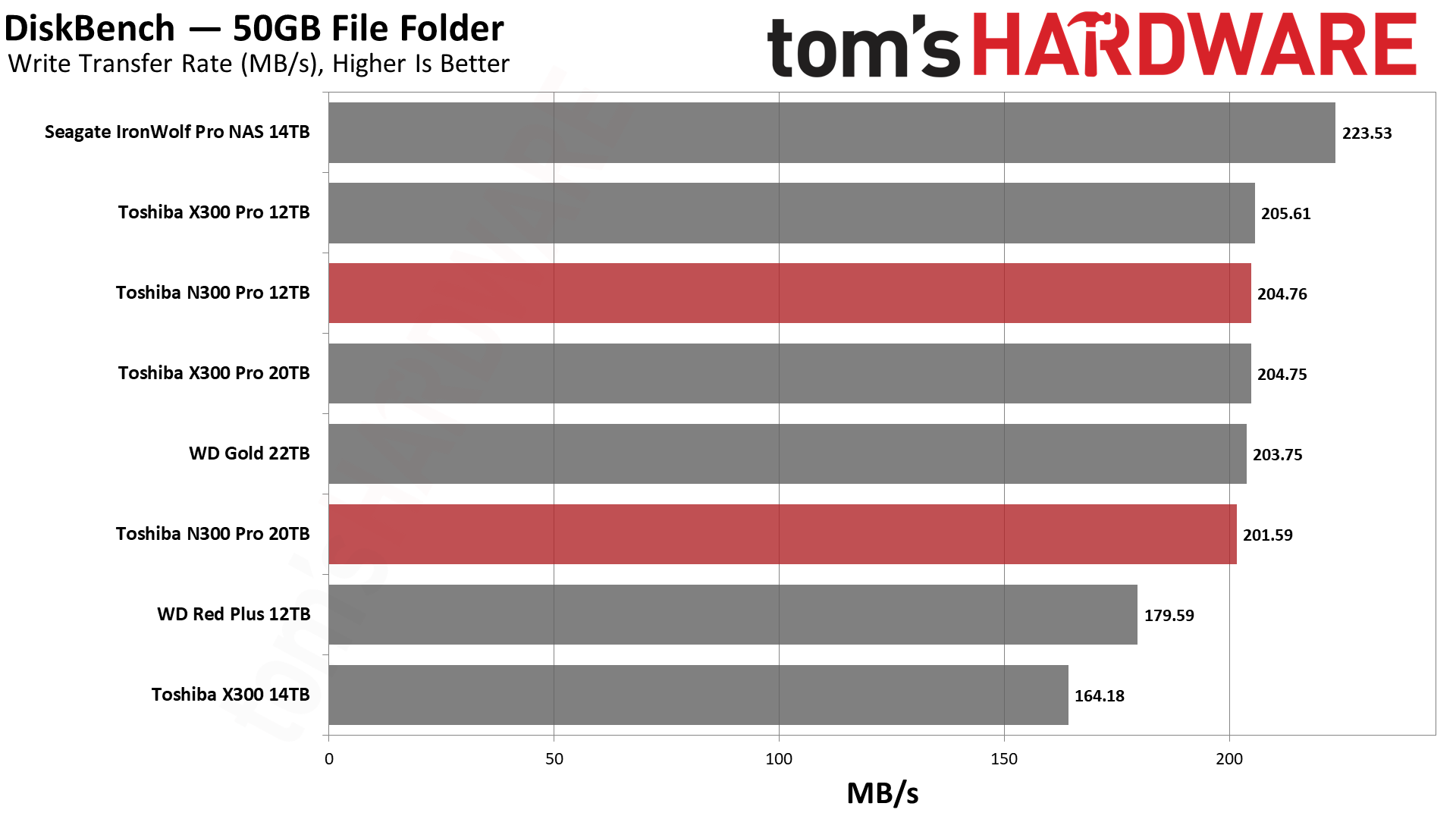

The N300 Pro has good read and write speeds but only mediocre copy transfer rates. Around 100 MB/s for a 20TB drive is acceptable. The 12TB is slower, as expected, but still beats the Red Plus as well as the lower capacity IronWolf Pro 14TB.
Get Tom's Hardware's best news and in-depth reviews, straight to your inbox.
Synthetic Testing — ATTO / CrystalDiskMark
ATTO and CrystalDiskMark (CDM) are free and easy-to-use storage benchmarking tools that storage vendors commonly use to assign performance specifications to their products. Both of these tools give us insight into how each device handles different file sizes.


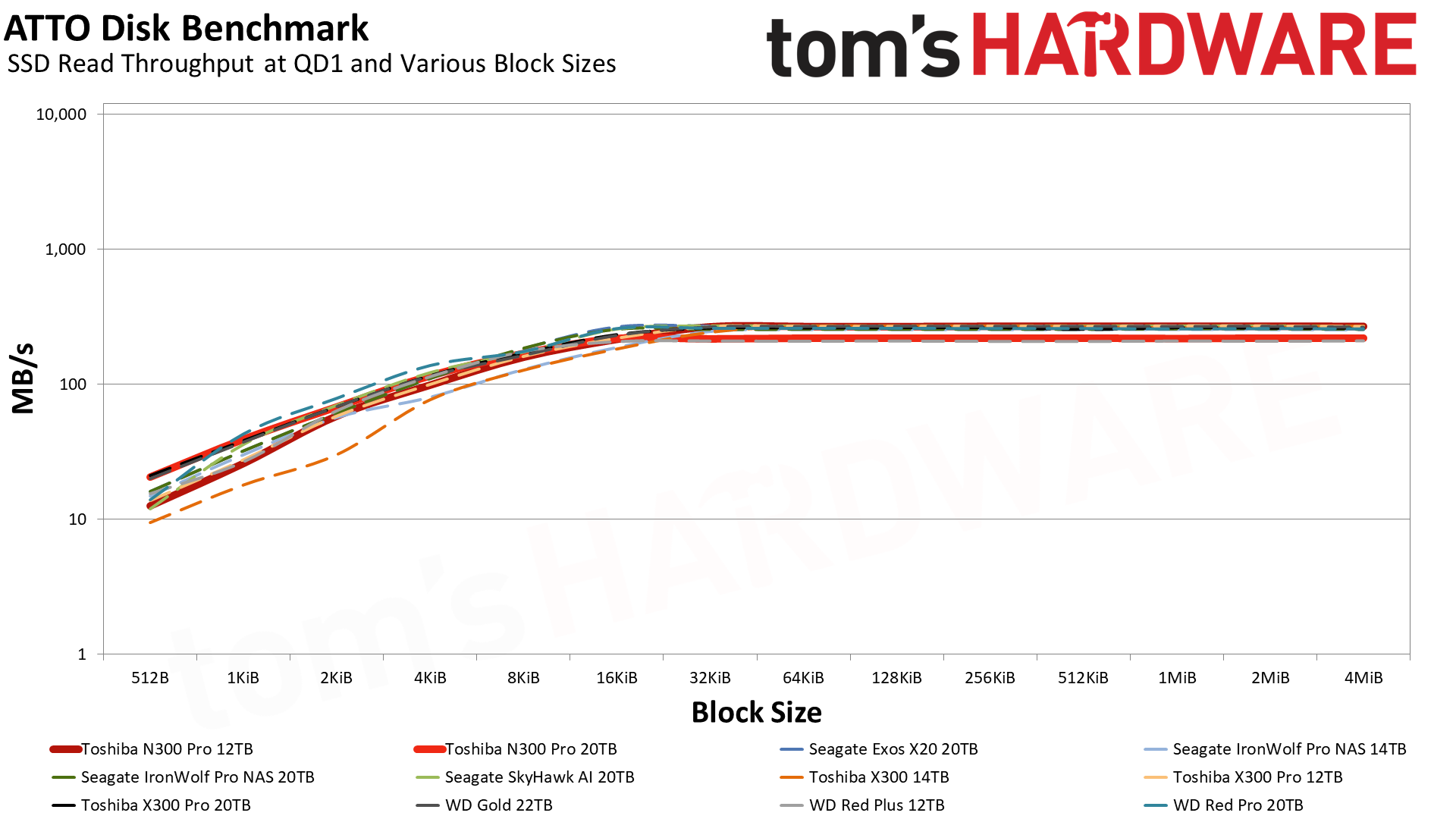




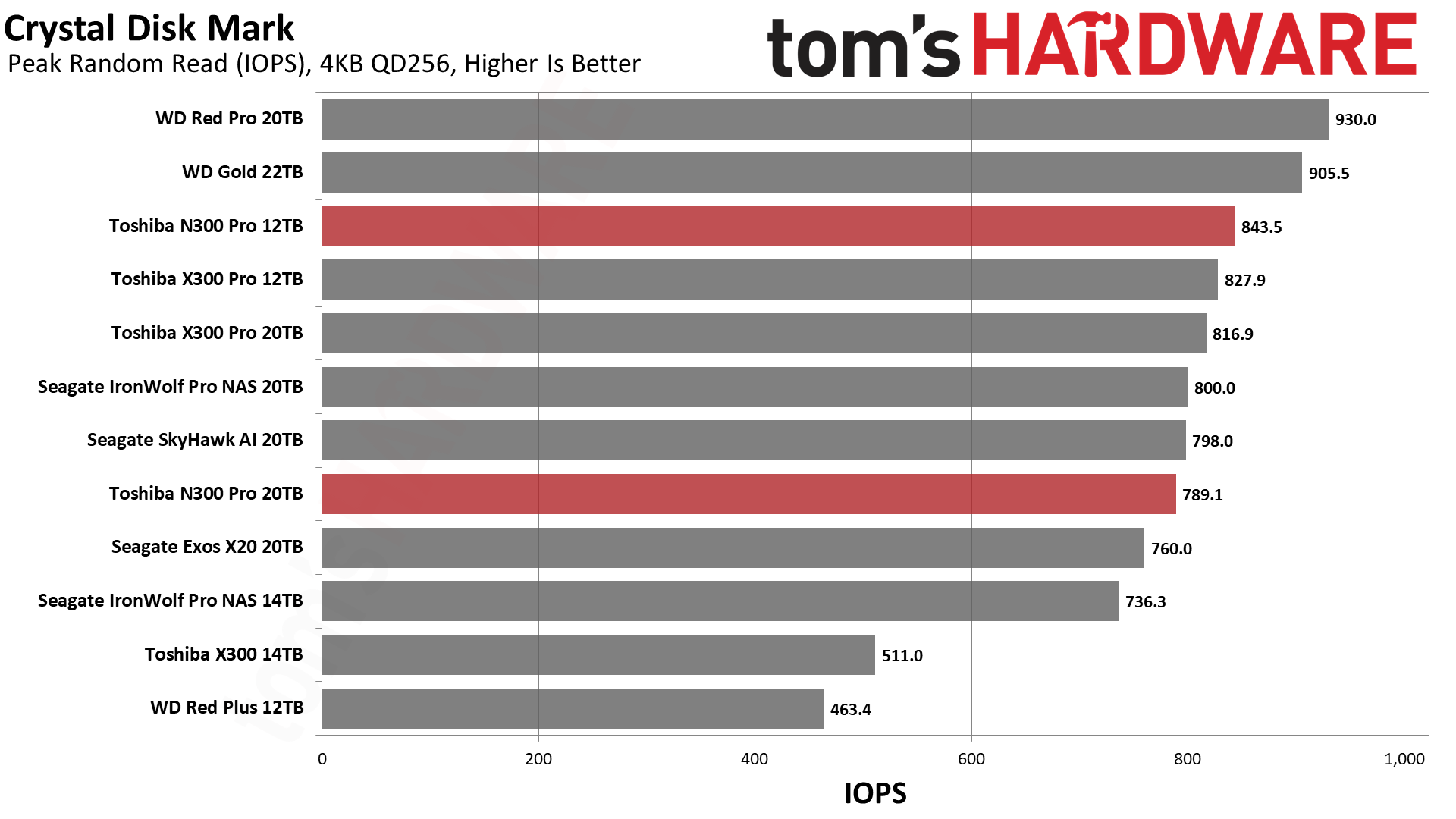






Random 4KB performance is not a strong suit of any HDD as you are likely to be dealing with larger block sizes on workloads intended for mechanical storage. A little extra boost doesn’t hurt, though, and the N300 Pro at least has decent read latency there.
What we will take a closer look at is 1MB QD1 sequential marks from CDM as many transfers fall along those lines. The 12TB N300 Pro tops the charts here, for both reads and writes. This lines up with the on-paper specifications and suggests Toshiba is using large platters for this and the 12TB X300 Pro.
Considering 12TB is above anything offered with traditional consumer desktop lines — the WD Black tops out at 10TB, the Blue and Seagate FireCuda at 8TB — this makes the N300 Pro an interesting choice if you’re looking at a capacity that carries less of a premium. It certainly outperforms the competition, like the Red Plus. This is likely due to Toshiba being a little late to the game with its technology and intention to grab market share, so its lower-capacity models are relatively faster.
If instead you need raw density with 20TB drives, the N300 Pro is sufficient but has to be less expensive to be worthwhile. Seagate's Exos line often has sales that deliver an excellent price per TB with good performance as well.
Sustained Write Performance
Official write specifications are only part of the performance picture. Most HDDs implement a write cache which is a fast area of volatile memory such as DRAM. Sustained write speeds directly hit the platters and tend to be consistent. There are exceptions to both of these statements as there are SSHDs (flash-containing hybrid HDDs), OptiNAND drives, and SMR drives that deviate from the traditional configuration. We use Iometer to detect the maximum sustained write speed of the HDD.



The results here are similar to the hints from CDM: the 12TB outperforms expectations and the 20TB is simply adequate. We can recommend either, but wait for the price to drop on the 20TB. In fact we can recommend the 14TB, 16TB, and 18TB as well, since these grade along similar lines and might be less expensive than the competition. This would also apply to the X300 Pro, which is a very similar drive, with the N300 Pro being most suitable for a multi-drive solution.
If you’re not needing anything special and find a good deal, shucking is probably still the way to go for high capacity. That makes sense for a home user looking to add a drive or two.
Power Consumption
We use the Quarch HD Programmable Power Module to gain a deeper understanding of power characteristics. Idle power consumption is an important aspect to consider, especially if you're looking for a laptop upgrade as even the best ultrabooks can have mediocre storage.
Some drives can consume watts of power at idle while better-suited ones sip just milliwatts. HDDs of course have much higher idle power use than SSDs, due to the moving parts. Average workload power consumption and max consumption are two other aspects of power consumption, but performance-per-watt is more important. A drive might consume more power during any given workload, but accomplishing a task faster allows the drive to drop into an idle state more quickly, ultimately saving energy.




It’s also nice to see that the N300 Pro isn’t the least-efficient drive in the mix. The 12TB does pretty well, all things considered. The 20TB less so, but any large HDD is going to pull a significant amount of power. Especially in multi-drive environments this also means a lot of noise, but that’s inescapable. The Red Plus is a quieter solution but is capacity-limited and less performant.
Test Bench and Testing Notes
| CPU | Intel Core i9-12900K |
| Motherboard | Asus ROG Maximus Z790 Hero |
| Memory | 2x16GB G.Skill DDR5-5600 CL28 |
| Graphics | Intel Iris Xe UHD Graphics 770 |
| CPU Cooling | Enermax Aquafusion 240 |
| Case | Cooler Master TD500 Mesh V2 |
| Power Supply | Cooler Master V850 i Gold |
| OS Storage | Sabrent Rocket 4 Plus 2TB |
| Operating System | Windows 11 Pro |
Toshiba N300 Pro Conclusion
The Toshiba N300 Pro is a competent HDD, even if it doesn’t stand out at 20TB against the competition. Its warranty is middle-of-the-road — better than the N300's 3-year and 180TB/year, but not up to the level of 550TB/year with data protection services. Performance is also adequate, and current pricing will likely be the critical factor.
Toshiba does make a name for itself by generally providing more cache, which is useful in multi-drive NAS environments, and with better sequential performance at sub-20TB capacities. With pricing and availability the way it is, this makes the 12TB model more enticing than the 20TB. The competition has a little extra capacity at up to 22TB, too. As of the time of review, the 12-18TB range is therefore the most attractive.
The N300 Pro makes the most sense in systems with many drives as that’s what separates it from the mainline X300 Pro. If you need a more traditional HDD with high capacity, the X300 Pro makes more sense — though if the N300 Pro has lower pricing, the two are otherwise quite similar. At 8TB and below there are many more consumer options. For other specialty uses, like surveillance, there are excellent drives from WD and Seagate like the Purple Pro and Skyhawk AI. While it’s common to buy external HDDs for shucking — or alternatively refurbished enterprise drives — for general home and residential NAS use, businesses can benefit from a streamlined model like the N300 Pro.
This still leaves a question about whether to go with the N300 or N300 Pro as they share many characteristics. The primary difference would be in the warranty, which is dependent on your SOHO or small business needs. In our opinion, it’s worth getting a 5-year warranty regardless, and the 300TB/year annualized workload rate should be sufficient. For a less rigorous environment, the regular N300 — which right now is best-priced at 16TB — is enough. In either case, this type of drive only makes sense if you intend to run multiple together in one system.
The 20-22TB cap that exists right now is a technology limit that has been around a while and will soon be overcome. Much more capacious drives are planned from all of the major manufacturers. The storage market is such that availability is not assured and pricing is volatile, which has made the secondary and shucking markets more viable, particularly for everyday storage use scenarios. It’s worth taking this into consideration when picking an HDD with the knowledge that a 12TB–18TB N300 Pro will provide a good experience for your multi-bay NAS at this time, if that’s what you need.
MORE: Best Hard Drives
MORE: Best SSDs
MORE: How We Test HDDs And SSDs
- 1
- 2
Current page: Toshiba N300 Pro 12TB/20TB Performance Results
Prev Page Toshiba N300 Pro Features and Specifications
Shane Downing is a Freelance Reviewer for Tom’s Hardware US, covering consumer storage hardware.
-
atomicWAR Great to see more 20TB options but pricing is going to kill this with Seagate Exos drives on Newegg frequently going for 269.99 when on sale, (currently 316.99 on newegg) Toshiba will have a hard time competing in the DIY market at a 439.99.Reply -
JarredWaltonGPU Reply
Yeah, it's the difficulty with all HDDs. When there's a slightly faster, cheaper, just as large HDD already available, what exactly is the selling point of these alternatives? I also wonder if there's really that much of a difference between the NAS models and the non-NAS models that would warrant the extra cost. Given the Backblaze approach, probably not.atomicWAR said:Great to see more 20TB options but pricing is going to kill this with Seagate Exos drives on Newegg frequently going for 269.99 when on sale, (currently 316.99 on newegg) Toshiba will have a hard time competing in the DIY market at a 439.99. -
atomicWAR Reply
Yeah pretty much. If I had to take a guess on why these might be worthwhile down the road, is when these drives price correct to slot into the market better. But who knows how long that could take...JarredWaltonGPU said:Yeah, it's the difficulty with all HDDs. When there's a slightly faster, cheaper, just as large HDD already available, what exactly is the selling point of these alternatives? I also wonder if there's really that much of a difference between the NAS models and the non-NAS models that would warrant the extra cost. Given the Backblaze approach, probably not. -
palladin9479 ReplyJarredWaltonGPU said:Yeah, it's the difficulty with all HDDs. When there's a slightly faster, cheaper, just as large HDD already available, what exactly is the selling point of these alternatives? I also wonder if there's really that much of a difference between the NAS models and the non-NAS models that would warrant the extra cost. Given the Backblaze approach, probably not.
There is a difference in the firmware and how the drive handles speeding up and down. NAS drives are spinning 24/7/365, they only spin up or down during restarts of the SP. Regular drives on the other hand will attempt to save power by spinning up / down on demand. This can cause lifetime reliability issues as the drive experiences the most stress when it's spinning up. Also there can be thermal considerations, regular drives know that they are primarily accessed in bursts and won't be expected to go 24/7/365, so they don't vent heat as well. NAS drives are expected to be rotating all the time and have better sustained thermal design.
I built my own NAS using FreeNAS and common parts off newegg/amazon. I made the mistake on my first array of using 7200RPM desktop performance drives. Ended up being a nightmare with thermals and I then swapped them for 5400RPM power saving drives, worked for awhile but then started having all sorts of problems. Finally bit the bullet and switched to 4x4TB WD Red 5400 and haven't had any problems in years. This system not only does typical CIFS shares for the house, but also iSCSI volumes for my ESXI system where I do lab work. -
JarredWaltonGPU Reply
Good to know it can actually make a difference, though I’d love to see someone do long-term testing with modern HDDs like the X300 Pro 20TB and N300 Pro 20TB. I’m sure the hardware is nearly the same (economies of scale being a big factor), and specs are otherwise very similar. Going from one set of 4TB 7200 RPM drives to a completely different set of 4TB 5400 RPM drives is obviously a significant change in the internal hardware.palladin9479 said:There is a difference in the firmware and how the drive handles speeding up and down. NAS drives are spinning 24/7/365, they only spin up or down during restarts of the SP. Regular drives on the other hand will attempt to save power by spinning up / down on demand. This can cause lifetime reliability issues as the drive experiences the most stress when it's spinning up. Also there can be thermal considerations, regular drives know that they are primarily accessed in bursts and won't be expected to go 24/7/365, so they don't vent heat as well. NAS drives are expected to be rotating all the time and have better sustained thermal design.
I built my own NAS using FreeNAS and common parts off newegg/amazon. I made the mistake on my first array of using 7200RPM desktop performance drives. Ended up being a nightmare with thermals and I then swapped them for 5400RPM power saving drives, worked for awhile but then started having all sorts of problems. Finally bit the bullet and switched to 4x4TB WD Red 5400 and haven't had any problems in years. This system not only does typical CIFS shares for the house, but also iSCSI volumes for my ESXI system where I do lab work.
I don’t use HDDs much these days, but I also tend to turn off the drive power down feature in Windows because I don’t want to have to wait for a drive to spin back up. I’ve heard in the past that spin up/spin down is one of the hardest things on HDDs in terms of wear and tear as well.
